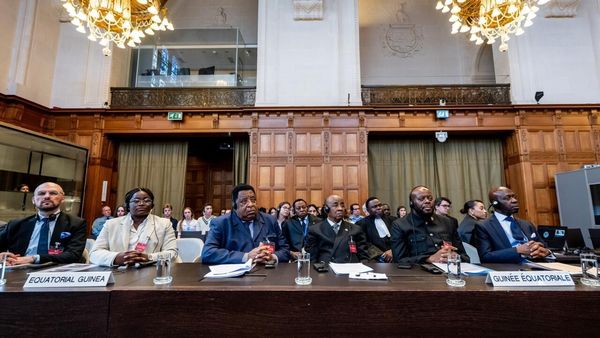
The fury among low-paid teachers that triggered a wildcat teachers’ strike in West Virginia—the longest in the state’s history—may be spreading.
Teachers in states across the country may soon build on West Virginia’s example. The Oklahoma teachers’ union said it will shut down schools there within months if its demands aren’t met, and some teachers said they may strike, regardless of what the union says. Even a new deal announced Tuesday in West Virginia was met with skepticism as the legislature quickly voted to approve it.
“The end goal is funding for public education and our core services, and if it takes us closing down schools to do that, then we are prepared and willing to do so,” said Alicia Priest, president of the Oklahoma Education Association. On Thursday, the OEA will announce a timetable that could culminate in a school shutdown if lawmakers don’t pass teacher raises, something the legislature hasn’t done in a decade. While some teachers may have been ‘on the fence,’” said Priest, the two-week West Virginia strike “has given them an emboldened sense of purpose and a sense of power.”
That may not be enough for the rank and file. Some Oklahoma teachers are planning a wildcat strike of their own. Leaders from a dozen schools met Friday to discuss such an unsanctioned walkout, and they plan to reconvene Wednesday to vote on a strike date. If the union’s plans aren’t to their liking, they may walk out, said Larry Cagle, who teaches advanced placement courses and is one of the organizers behind the independent effort. “We’re going to force this on the union and on the superintendent,” he said. “Teachers are ready—they are chomping at the bit.”
“A lot of people do not trust the promises made by the governor.”
American teachers have a tailwind, thanks to a tightening private-sector labor market, which brings stronger state revenue as well as alternative job opportunities, said Heidi Shierholz, who served as chief economist for the U.S. Department of Labor during the Obama administration. “The argument that the money just isn’t there, that it’s ‘blood from a stone,’ rings a lot more hollow at a time like this,” said Shierholz, who now directs policy for the Economic Policy Institute.
Hiking teacher pay may be necessary to stay competitive in a tighter private-sector labor market, said Chris Edwards, an economist at the Cato Institute. However, states that buckle to pressure from striking teachers could be in trouble when the economy goes south, he added.
“If they do make big commitments, then a recession comes, then they get themselves into budget troubles,” said Edwards.
In West Virginia, the strike by thousands of school employees began Feb. 22 with the backing of the schools’ three unions, and then morphed into a rare “wildcat” walkout when teachers rejected an agreement between union leaders and the governor. Teachers said they were concerned the deal didn’t offer a concrete solution to the pressing issue of escalating health insurance premiums, and they lacked faith that the legislature would approve the 5 percent raises agreed to by Governor Jim Justice, a Republican.
“A lot of people do not trust the promises made by the governor,” striking teacher Kristina Gore said Thursday after West Virginia’s Republican-controlled Senate shunted the proposed pay raise to committee. On Saturday night, the Senate voted to approve raises of only 4 percent for the teachers, who have not had an across-the-board increase since 2014.
On Tuesday, legislative leaders and Justice announced a new deal to fund 5 percent raises. The package includes a 16-month freeze on premium increases under the teachers’ health care plan, according to the state’s American Federation of Teachers local. Rather than counting on the additional revenue projected by the governor’s office, Senate Finance Chair Craig Blair said Tuesday morning that the chamber would make “very deep cuts” elsewhere in the budget to compensate for the raises. The legislature approved the deal Tuesday afternoon.
Several teachers said Tuesday morning that they’re willing to return to work if the new deal is signed into law—but not before then.
“None of us are holding our breath,” said striking teacher Tiphani Davis. “They have proven to be dishonest.”
“Teacher strikes have tended to breed more teacher strikes.”
A favorable economic landscape notwithstanding, this year is shaping up to be a perilous one for the already embattled U.S. labor movement, with the White House and Republican-controlled Congress hostile to unions and a U.S. Supreme Court ruling expected by summer that may slash their budgets and bargaining power by outlawing mandatory union fees in the public sector. Nevertheless, the West Virginia walkout has provided a beacon of sorts for activists who see it as the stirrings of grassroots organizing and defiance that they say the movement needs to survive. “Everybody I know is excited about this and what it shows is possible,” said former Communications Workers of America President Larry Cohen, who now chairs Our Revolution, the advocacy group of Senator Bernie Sanders, Democrat of Vermont.
If the strike spreads to other states such as Kentucky, where teachers are fighting lawmakers over pay and benefits, it wouldn’t be the first time. “Historically, public-sector strikes have tended to come in waves,” said Georgetown University historian Joseph McCartin. “Teacher strikes have tended to breed more teacher strikes.” From 1945 to 1950, there were around 60 work stoppages by teachers around the country, many mounted without official union backing or legal protection. At the time, said McCartin, schools were underfunded and classrooms increasingly crowded. Teachers felt left behind amid quickening private sector wage growth in a postwar economy.
Teachers in Oklahoma have now gone without raises for a decade. Average pay there is the lowest in the U.S., according to Bureau of Labor Statistics data. Jonathan Small, president of the conservative think tank Oklahoma Council of Public Affairs, said he expects the Republican-controlled legislature to approve a raise for educators. Small said he would support an increase of at least $5,000 a year for each teacher, at a cost of about $246 million, which could be paid for by spending down a surplus while increasing the state’s gross production tax on oil and natural gas.
Many Oklahoma teachers aren’t willing to wait and see what the legislature does. “People are talking about ‘strike’ now out in the open, and that’s been a change,” said John Waldron, a teacher and local union delegate. “The groundswell right now is pretty loud.” Union leaders are hearing regularly from members who want to go on strike, and that pressure has helped force the leadership’s hand, said Waldron, a Democratic candidate for the state legislature.
In a statement, Oklahoma state Senator Greg Treat, the Republican majority floor leader, said “teachers deserve a pay raise” and that lawmakers have “repeatedly, in a bipartisan manner, passed revenue plans to fund teacher pay.” He claimed that Democrats have obstructed such efforts.The threat of a wildcat strike in Oklahoma has even split the labor movement there. Priest, the Oklahoma union president, argued that the vast majority of teachers “are on the same page” about strategy, notwithstanding a few groups “that don’t have all of the information.” Before shutting down schools, she said, the union will push for local school board resolutions endorsing school funding hikes and expressing support for teachers in the event of a shutdown. “We have an opportunity to stand together in a unified voice,” she said, “and we need to do so.”
To contact the author of this story: Josh Eidelson in Washington at jeidelson@bloomberg.net.
To contact the editor responsible for this story: David Rovella at drovella@bloomberg.net.
©2018 Bloomberg L.P.







